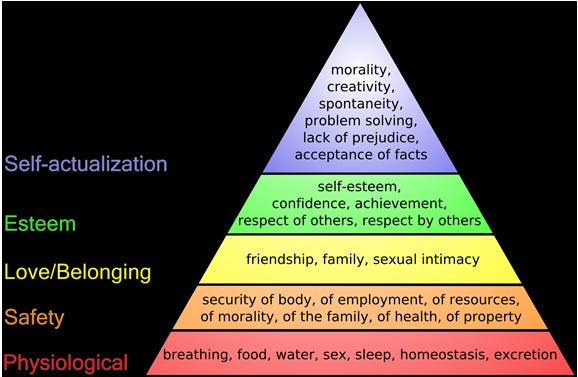The Hierarchy of Worldbuilding
How Maslow’s Triangle Can Help You Build Fictional Worlds That Actually Make Sense
Worldbuilding is one of the great playgrounds of writing. Whether you’re crafting an earth-like alternate reality (hello, Middle Earth and Hogwarts), inventing a faraway planet for your sci-fi epic, or building a cozy magical town with harbor boats and witches (ahem), your story world needs structure.
Not just pretty scenery — structure.
A world that feels real to the reader has to function under a consistent set of rules. If your characters exist inside a world of contradictions, loose ends, and missing logic, even the best plot or most lovable characters will stumble.
The good news? There’s a simple and time-tested tool you can use to give your world the solid foundation it needs: Maslow’s Hierarchy of Needs.
Yes — the famous little triangle from Psych 101.
While your world may have flying jellyfish, zero gravity, or fire-breathing hedgehogs, your readers are still human. And humans subconsciously expect worlds that address basic survival and social structures — even when those worlds are wildly unfamiliar.
Maslow’s Hierarchy — Your Worldbuilding Blueprint
Let’s walk the triangle. You can use these prompts as a checklist for your own worldbuilding journal (and I highly recommend you keep one).
🔻 Level 1: Physiological Needs
Breathing
Is the atmosphere breathable? Do your creatures need oxygen? Gills? Filtration masks?
Can visitors from other worlds breathe the air, or do they need apparatuses?
Food
What counts as food? How is it gathered, grown, or produced?
What does it taste like, feel like, sound like while eating?
Are there regional food cultures? Food scarcity? Allergies? Food rituals?
How does digestion work?
Water (or equivalent)
Does your world need water? If not, what sustains life?
How do beings hydrate? How do they clean themselves? What do they drink?
Sleep
Do your beings sleep? Hibernate? Regenerate?
How much sleep is needed? Is it culturally respected or resented?
Is sleep tied to light cycles or environmental factors?
Sex & Reproduction
How do beings reproduce? Babies? Cloning? Spawning pods?
Is sex culturally important, casual, taboo, or ceremonial?
What constitutes partnership or family? Are genders involved?
Environment
Describe the landscape, weather, flora, fauna, and natural cycles.
What’s beautiful? What’s dangerous? What’s sacred?
Are there natural disasters or environmental threats?
🔻 Level 2: Safety Needs
Government and Justice
Who makes the rules? Who enforces them?
Is there police, military, elders, AI overlords?
How are conflicts resolved?
Religion & Morality
What belief systems exist?
Is there a god, gods, or no god at all?
What constitutes right and wrong? Are these standards universal or contested?
Economy & Resources
How do beings obtain goods? Barter? Currency? Communal sharing?
Is there poverty? Class structure? Scarcity? Overabundance?
Family & Social Structure
What does "family" mean here? Bloodlines? Bonds? Assigned units?
How do they handle aging, parenting, friendship, marriage?
What groups are privileged? What groups are marginalized?
What is honorable or shameful in this culture?
🔻 The Higher Levels (Love, Esteem, Self-Actualization)
Even if you stop after the first two tiers, your world will be sturdier than most. But if you want real depth, work your way up:
How do beings experience friendship, romance, loyalty?
What brings individuals pride or disgrace?
What makes a life feel fulfilled in this world?
Are there artists, philosophers, seekers?
What cultural forces shape ambition, creativity, or service?
The Payoff: Why This Work Matters
When you know these answers, you’re no longer winging it. The world breathes. The rules make sense. Your readers stop asking "Wait, how does that work?" and instead sink fully into your story.
You may be writing about aliens — but you’re not writing for aliens. You're writing for humans who want to believe in your world.
One Last Rule:
Don't let the audience see your scaffolding.
You’re not dumping all these details into your story. You’re using this background work to inform small, natural touches that make your world feel lived in. The reader may never know how your characters metabolize food or what governs sleep cycles — but you will, and it shows.


